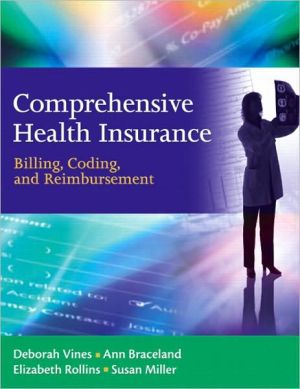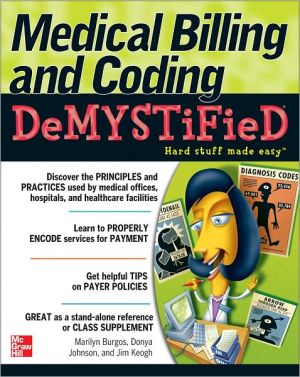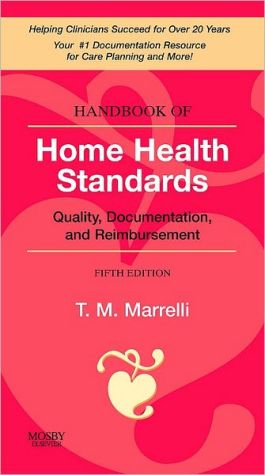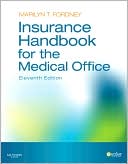Comprehensive Health Insurance: Billing, Coding, and Reimbursement [With CDROM]
This book was written to provide trainees with the knowledge and skills necessary to work in a variety of medical billing and coding positions in the medical field. Easy to read and comprehend, it is designed for professionals who have not previously worked in the medical field as well as professionals who have worked in the field but have only been exposed to certain aspects of the billing process. In order to adapt to the growing number of facilities that are becoming more automated, this...
Search in google:
This book was written to provide trainees with the knowledge and skills necessary to work in a variety of medical billing and coding positions in the medical field. Easy to read and comprehend, it is designed for professionals who have not previously worked in the medical field as well as professionals who have worked in the field but have only been exposed to certain aspects of the billing process. In order to adapt to the growing number of facilities that are becoming more automated, this book not only reviews non-automated procedures but it also gives in-depth content on automated procedures. A few exciting features to this book are: Case Studies with Critical Thinking Questions; a key terms list appears at the beginning of each chapter; Professional Tips appear throughout the text and provide additional information related to billing and coding processes; and any material within the text that is related to HIPAA is flagged with an icon so that students can identify the “need to know” law.
PrefaceSection I — A Career in HealthcareCHAPTER 1: INTRODUCTION TO PROFESSIONAL BILLING AND CODING CAREERSEmployment DemandFacilitiesPhysician PracticeHospitalCentralized Billing OfficeJob DescriptionsMedical Office AssistantMedical BillerMedical CoderRegistered Health Information Technicians (RHIT)Payment PosterMedical CollectorRefund SpecialistInsurance Verification RepresentativeAdmitting Clerk or Front Desk RepresentativePatient Information ClerkProfessional MembershipsCertificationMedical Office Assistant CertificationMedical Billing CertificationsMedical Coding CertificationsMedical Records CertificationResourcesSection II: Relationship between the Patient, Provider and CarrierCHAPTER 2: MANAGED CARE TERMINOLOGYThe History of Healthcare in AmericaMedical ReformDefinition of Managed Health CareManaging and Controlling Cost Discounted FeesPatient Care Delivered Is Medically NecessaryCare Rendered By Appropriate ProviderAppropriate Medical Care in Least Restrictive SettingWithholding Providers’ FundsInsurance PlansCommercial Health InsuranceTypes of Managed Care Organizations Health Maintenance Organizations (HMO) Preferred Provider Organization (PPO)Point Of Service Options (POS)Criticism of MCOsAlternative Health Care PlansExclusive Provider Organization (EPO) Independent Physician Association (IPA) Physician-Hospital Organization (PHO) Self-insured EmployersTypes of Insurance Coverage Hospital Hospital Indemnity Insurance Medical Surgical OutpatientMajor MedicalSpecial RiskCatastrophic Health InsuranceShort-Term Health InsuranceCobra InsuranceFull-Service Health InsuranceLong-Term CareSupplemental InsuranceThe Provider’s View of Managed CareRestrictionsOpportunitiesPatient CareFacility OperationsCollection of FundsAssignment of BenefitsCHAPTER 3: UNDERSTANDING MANAGED CARE: MEDICAL CONTRACTS AND ETHICSPurpose of a ContractA Legal AgreementCompensation and Billing GuidelinesCovered Medical ExpensesPaymentEthics in Managed CareChanges in Health Care DeliveryEthics of the Medical Office SpecialistContract DefinitionsCompensation for ServicesPatient Bill of RightsSection III: Medical CodingCHAPTER 4: ICD-9 MEDICAL CODINGDefinitions of Diagnosis CodingHistory of Diagnosis CodingPurpose of ICD-9-CMAddendaThe Future of Diagnostic Coding: ICD-10-CMThe Three Volumes of the ICD-9-CM Volume I: Tabular/Numerical List of DiseasesVolume II: Alphabetic Index of DiseasesVolume III: Tabular and Alphabetic Index of ProceduresProper Use of the ICD-9-CMICD-9-CM ConventionsThe Alphabetic Index- Volume 2Supplementary TermsIntroduction to Volume IThe Tabular List: Volume IHow to CodeKey Coding GuidelinesPrimary Diagnosis First, Followed by Current Coexisting ConditionsCode to Highest Level of CertaintyCode to the Highest Level of SpecificitySurgical CodingCoding Late EffectsAcute and Chronic ConditionsCombination Code — Multiple CodingV CodesE CodesSupplemental Classification of External Causes of Injury and PoisoningNeoplasm TableThe Fifth-digit Behavior CodesCoronary Artery DiseaseIschemic Heart DiseaseHypertension TablePoisoning and Adverse Effects of DrugsBurnsDiabetesInjuries, Complications and AccidentsFracturesOther ScenariosNine Steps for Accurate ICD-9-CM CodingCHAPTER 5: INTRODUCTION TO CPT AND PLACE OF SERVICE CODINGCPTCPT CategoriesCategory ICategory IICategory IIICPT NomenclatureSymbolsGuidelinesModifiersList of Modifiers for Evaluation and Management CodingCoding to the Place of ServiceOffice vs. Hospital ServicesEmergency Department ServicesPreventive Medicine ServiceType of PatientNew PatientEstablished PatientReferralConsultationLevel of E/M ServiceExtent of Patient’s HistoryExtent of ExaminationComplexity of Medical Decision MakingAdditional ComponentsAssigning the CodeCHAPTER 6: CODING PROCEDURES AND SERVICESOrganization of the CPT Index Instructions for Using the CPT Format of the TerminologyFormatCross-referencesSection GuidelinesModifiersCoding StepsCoding for AnesthesiaSurgical CodingAdd-On Codes (+)Separate ProcedureSurgical Package or Global Surgery ConceptSupplies and ServicesPost-op Follow up 99024Radiology CodesPathology and Laboratory CodesMedicineCHAPTER 7: HCPCS AND CODING COMPLIANCEHistory of HCPCSHCPCS Level of CodesLevel I — CPTLevel II - HCPCS National CodesLevel III — Local CodesHCPCS ModifiersThe Use of the GA ModifierIndexCoding Linkage and Coding ComplianceCode LinkageBilling CPT-4 CodesFederal LawPhysician Self-ReferralGovernment Investigations and AdviceErrors Relating to Code Linkage and Medical Necessity Errors Relating to the Coding ProcessErrors Relating to the Billing ProcessNational Correct Coding Initiative (NCCI)Fraudulent Actions and Compliance ErrorsComplianceHow to be CompliantBenefits of a Voluntary Compliance ProgramEthics for the Medical CoderCHAPTER 8: AUDITINGAuditingExternal AuditInternal AuditPurpose of an AuditPrivate Payer RegulationsMedical Necessity for E/M ServicesAudit ToolKey Elements of ServiceHistoryExaminationMedical Decision MakingTips for Preventing Coding Errors with Specific E/M CodesSection IV: Medical ClaimsCHAPTER 9: PHYSICIAN MEDICAL BILLINGPatient InformationSuperbillsTypes of Insurance ClaimsOptical Character RecognitionCMS — 1500 FormPhysicians’ Identification NumbersCommon Reasons why CMS-1500 Claim Forms are Delayed or RejectedHIPAA Compliance AlertFiling Secondary ClaimsDetermining Primary CoverageCHAPTER 10: HOSPITAL MEDICAL BILLINGInpatient Billing ProcessCharge Description MasterTypes of PayersCoding and Reimbursement MethodsDiagnosis Related Group System (DRG)Cost OutliersICD-9CM Procedural CodingHospital Billing Claim Form (UB-04)Instructions for Completing UB-04Codes for UB-04Sex CodesAdmission CodesDischarge CodesCondition CodesOccurrence Code Examples (Form Locater 31-34)Value CodesRevenue CodesPatient RelationshipSection V: Government Medical BillingCHAPTER 11: MEDICARE MEDICAL BILLINGMedicare HistoryMedicare AdministrationMedicare Intermediary- Part AMedicare Carrier— Part BClaim Processing: Medicare Part A Provider- IntermediaryInpatient Hospital CareSkilled Nursing FacilityHome Health CareHospice CareInpatient Benefit DaysBasic DaysCo-Insurance DaysLifetime Reserve Days (LTR)Skilled Nursing FacilityHospice CareClaims Processing: Medicare Part B- CarrierMedicare Part CMedicare Part DServices Not Covered by Medicare Part A and Part BRequirements for Medical NecessityFee-for-Service: The Original Medicare PlanMedicare Advantage Plus or Medicare Part CMedicare Coverage and EligibilityMedicare ProvidersPart A ProvidersPart B ProvidersParticipating vs. Non-participatingLimiting ChargeDetermining the Medicare Fee and Limiting ChargePatient RegistrationCopying the Medicare CardObtaining Patient SignaturesDetermining Primary or Secondary PayerPlans Primary to MedicareConsolidated Omnibus Budget Reconciliation Act of 1985 (COBRA)DisabledEnd-stage Renal Disease (ESRD)Workers’ CompensationAutomobile, No-Fault and Liability InsuranceVeteran BenefitsMedicare Coordination of Benefits Contractor (COB)Hospital RegistrationMedicare as the Secondary PayerMedigap, Medicaid and Supplemental InsuranceConditional PaymentMedicare DocumentsDevelopment LetterMedicare Insurance Billing RequirementsHCPCSCompleting Medicare Part B ClaimsForm Locators for Medicare Part B ClaimsRailroad RetirementO MEDICARELocal Coverage Determination (LCD)Medicare Remittance NoticeCMS-1500 FORM — Form Locator 29Determining Medicare Fraud and AbuseCommon types of Medicare abuseCHAPTER 12: MEDICAIDMedicaid GuidelinesEligibility GroupsCategorically NeedyMedically NeedyImmigrantsTANFState Children’s Health Insurance Program (SCHIP or CHIP)Scope of Medicaid ServicesPACEAmount and Duration of Medicaid ServicesPayment for Medicaid SErvicesMedicaid Summary and TrendsThe Medicaid- Medicare Relationship (Medi-Medi)Medicaid Managed CareMedicaid VerificationMedicaid Claims FilingTime Limits for Submitting ClaimsExceptions to the 95-Day Filing DeadlineAppeal Time LimitsClaims with Incomplete Information and Zero Paid ClaimsNewborn Claim HintsCompleting the CMS-1500 for Medicaid (Primary) CHAPTER 13: TRICARETricare Fiscal YearAuthorized Providers PreauthorizationTricare StandardNon-availability statement (NAS)Tricare PrimeTricare Prime Remote (TPR)Tricare EXTRATricare Senior Prime Tricare for LifeCHAMPVASubmitting Claims to TricareCompleting the CMS-1500 for Tricare (Primary)Timely FilingConfidential and Sensitive InformationPenalties and Interest ChargesSection VI: Accounts ReceivableCHAPTER 14: EXPLANATION OF BENEFITS AND PAYMENT ADJUDICATIONSteps for Filing a Medical ClaimClaim ProcessAdjudicationDetermining the FeesCharge-based fee structuresResource-based fee structuresHistory of the RBRVSResource Based Relative Value Scale (RBRVS)Determining the Medicare FeeAllowed ChargePayers PoliciesCapitationCalculations of Patient ChargesDeductibleCopaymentsCoinsuranceExcluded ServicesBalance BillingProcessing an EOB Information On An EOBUsing Claims InformationAdjustments to Patient Accounts Processing Reimbursement InformationDetermining the Amount Paid/Adjustments/Patient DueMethods of Receiving FundsCheck by MailElectronic Funds Transfer (EFT) Lock Box ServicesCHAPTER 15: REFUNDS AND APPEALSReimbursement Follow-upRebillingDenied or Delayed PaymentsAnswering Patients’ Questions about ClaimsClaim Rejection AppealPeer Review State Insurance Commissioner Carrier AuditsDocumentationSOAP (Format of Record Keeping)Documentation GuidelinesRegistering a Formal AppealReason Codes That Require A Formal AppealThe Employee Retirement Income Security Act of 1974 (ERISA)Waiting Period For An ERISA ClaimAppeal to ERISAMedicare AppealsRedeterminationSecond Level of AppealThird Level of Appeal and BeyondNecessity of AppealClosing WordsAppealing Denied ClaimsDo Not Settle for “Denial Upheld”Refund GuidelinesAvoid Excessive OverpaymentsGuide to Insurance Overpayments and Refund Requests.Section VII: Injured Employee Medical ClaimCHAPTER 16: WORKERS’ COMPENSATIONHistory of Workers’ CompensationFederal Workers’ Compensation ProgramsState Workers’ Compensation PlansOverview of Covered Injuries, Illness, and BenefitsOccupational DiseasesWork-Related Injury ClassificationsInjured Worker Responsibilities and RightsTreating Doctor’s ResponsibilitiesSelecting a Designated Doctor and Scheduling an AppointmentCommunicating With the Designated DoctorWhat the Designated Doctor Will DoDisputing the Designated Doctor's FindingsMaximum Medical Improvement and ImpairmentDisputing Maximum Medical Improvement or Impairment RatingOmbudsmenTypes of Workers’ Compensation BenefitsMedical BenefitsIncome BenefitsDeath and Burial BenefitsEligible BeneficiariesDependent Child, Grandchild, and Other Eligible PartiesBenefits and Compensation TerminationDisability Compensation ProgramsTypes of Government Disability PoliciesVerifying Insurance BenefitsPreauthorizationRequirements For The Preauthorization RequestFiling Insurance ClaimsCompleting the CMS-1500 for Workers’ Compensation ClaimsIndependent Review Organizations How to Obtain an Independent Review The IRO DecisionMedical RecordsFraudPenaltiesMedical Provider FraudCalculate ReimbursementSection VIII: Computer ApplicationCHAPTER 17: MEDICAL CLAIMS PROCESSINGSimulation InstructionsTips for Entering Information into Medical Practice Management (MPM) SoftwareAppendix A: Completing the CMS-1500 Form (08/05): Case StudiesAppendix B: Completing the CMS-1500 Form and Determining the Diagnostic Code: Case StudiesAppendix C: Medical FormsAppendix D: Completing the UB-04 Form: Case StudiesAppendix E: AbbreviationsAppendix F: Medical Terminology Word PartsAppendix G: Helpful WebsitesAppendix H: HIPAA RegulationsAppendix I: Payment Posting Using Advanced NDC Medisoft (v. 12)GlossaryBibliography








